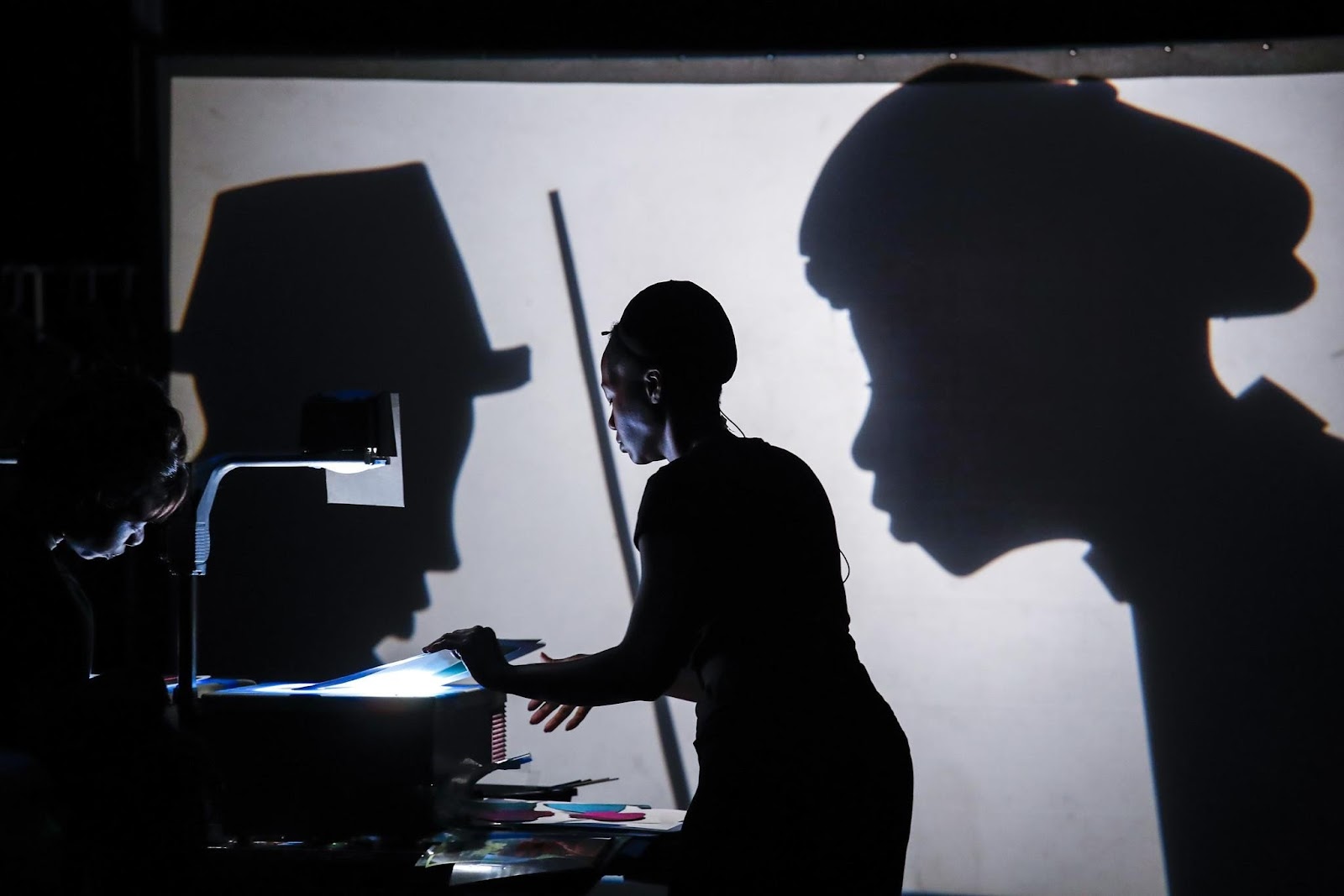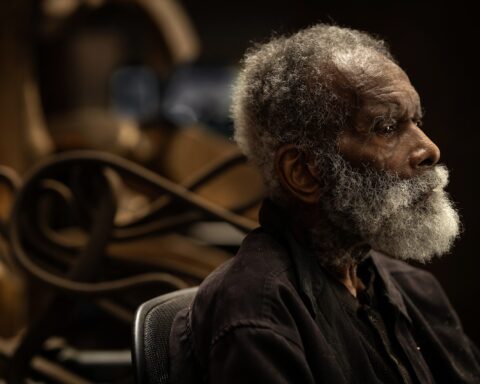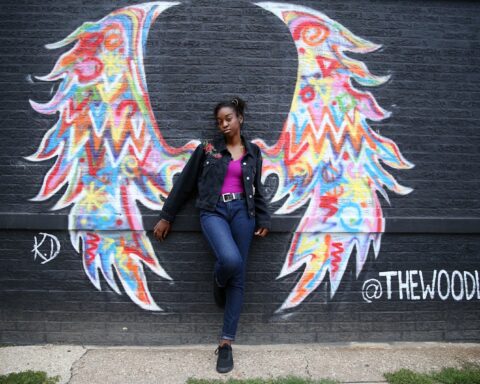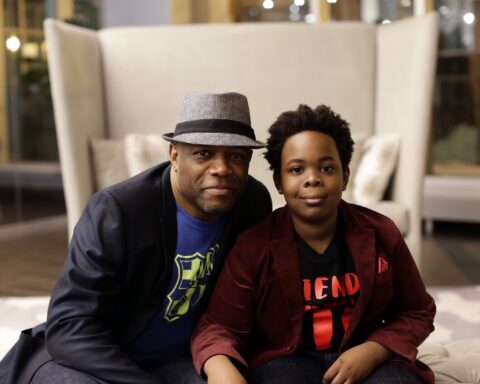Poet. Teacher. Mentor. All are words synonymous with Gwendolyn Brooks.
Born in Topeka, Kan., in 1917, Brooks made her name as a poet in Chicago. A Bronzeville resident, she grew up writing — writing about what she saw and heard in the street. In 1950, she was catapulted to national prominence when her second book of poetry, “Annie Allen,” won a Pulitzer Prize. At the time, her community was a dense hotbed for African-American art and music.
She is the subject of a new play, “No Blue Memories: The Life of Gwendolyn Brooks,” which will be staged in three performances this weekend at the Harold Washington Library Center. Produced by Manual Cinema, a Chicago-based company known for theater works combining live action and projections, “No Blue Memories” was written by Eve Ewing and Nate Marshall, both of Young Chicago Authors fame, from a commission by the Poetry Foundation.
The play touches on her character, love of language and a legacy that has never dimmed. “No Blue Memories” combines intricate paper puppetry, live actors working in shadow and an original score to create a unique multimedia experience that gives the audience glimpses of her greatness — glimpses anchored by what has come to be known as the “golden shovel,” a poetic form she has passed on to newer generations.
APRIL
The writing duo began by poring over the Gwendolyn E. Brooks Archive at the University of Illinois.
Brooks did not lead a particularly colorful or loud life. She lived and worked quietly on the South Side, preferring to spend much of her free time in schools with youngsters. She read her work to children, the incarcerated and patients in Cook County Hospital. She left those who heard her read spellbound. She worked at the South Side Community Arts Center (recently named a National Treasure by the National Trust for Historic Preservation) and made appearances there. Her works capture the black experience in a way that is timeless. Poet laureate of Illinois and the nation, she received more than 70 honorary degrees during her lifetime. Her name is engraved on the Illinois State Library in Springfield.
A year after her death in 2000, the then-director of Chicago State University’s Gwendolyn Brooks Center, B.J. Bolden, wrote of her in the Chicago Tribune: “In the popular world, she is a hero of the community. People see her as an ordinary person who really was extraordinary. She claimed to be humble. She wanted to be with the people. But she was a monumental role figure. She heightened awareness of the need for community. She was our truth-teller.”
“We don’t have a Gwendolyn Brooks major motion picture,” Ewing said. “We don’t have a ‘Hamilton’ for Gwendolyn Brooks. So I think for us, this is opening a conversation. We’re trying to make an argument about the arc of her life and also trying to showcase some aspects of her life that maybe people are not aware of.”
Ewing and Marshall found letters she wrote to children, incarcerated people and emerging writers like Etheridge Knight and Sandra Cisneros. They consider this endeavor as an opportunity to highlight Brooks’ “ever-evolving” voice over the course of her career. “I continue to see scholarship, especially from white literary analysts, that engages with the first half of her career and doesn’t ever really engage with anything from 1967 onward. Part of what we’re also trying to show is the wingspan of this amazing person and her vision.”
Puppet designer/storyboard creator Drew Dir describes the opening scene of the play: “We’ll open on a skyline of Chicago in 1950 and pan down into the city to rest on Gwendolyn’s house in the time period right after she’s won the Pulitzer Prize. People are outside her house — these two white ladies from the North Shore basically trespass in her yard to see where the great Negro poetess lives. The show will then go back to her childhood when she wrote her first poem and we’ll work through the decades through her whole life.”
MAY
Details for the video of Brooks’ iconic poem “We Real Cool” are reviewed. The video is released on Brooks’ June 7 birthday.
SEPTEMBER
Music composer Jamila Woods came aboard the project through Ewing and Marshall. “No Blue Memories” is the first time she has scored a play, and she’s doing it with her sister Ayanna.
“I loved that this project was a way to introduce Gwendolyn Brooks to young people, and also a way for longtime fans of her work to know her in a new way,” Jamila Woods said. “There are several moments in the script where a full poem is recited, so it’s been fun to play with setting those poems to music. I hope that the spirit of Gwendolyn Brooks comes through in the music.”
OCTOBER
Black cardboard cutouts of various nouns litter the desktop of Manual Cinema’s workspace — a space that looks part dorm room, part luggage storage and part puppeteer’s workshop.
N. LaQuis Harkins plays Brooks in the live-action scenes.
Terms like “poetry magic” and phrases “puppets are the backup in this moment” and “make really big knees and arms, otherwise you look like you’re on a Segway” are used in directions from director to performers. Director Sarah Fornace believes “No Blue Memories” to utilize around 400 puppets.
“This production is unique for us because it does involve so many words and so much text, because usually our whole idea is that we make live movies on stage through cinematic puppetry and they’re usually silent films, so through gesture and cinematic editing and framing, we get the story across, but this one has a whole script and all of this beautiful language,” she said.
The actors are the puppeteers and do voice-overs in the production. While juggling those duties, they also have to do costume changes and keep pace with the five-member band playing live music.
“We’re all finding it really hard to describe … because all of its aspects are kind of typical of theater, but the way that they’re all put together is very atypical,” actor Felix Mayes said.
Harkins attests she took Brooks for granted when she was younger. Now, as an adult, she finds herself being inspired by her.
“I love the work of Gwendolyn Brooks. I was excited to see her story told in this way,” she said. “It’s choreography, it feels like poetic lyricism. … The story, the background of Gwendolyn Brooks — what she meant to Chicago and the nation and the world and the rich culture of Bronzeville. She upheld that, she taught that, she lived that … she was that. And I want more people to know.”
NOVEMBER
All artists come out to sync with one another during rehearsals.
Actor Rasaan Khalil, who plays writer Haki Madhubuti in the production, practices his lyrical flow in conjunction with the puppeteers and musicians.
“Before, Gwendolyn Brooks was always somebody I just heard through education and as a black woman. You hear about her, but not really. She was always just a name,” said the 22-year-old student from Maywood.
Ayanna Woods is playing bass and piano next to sound designer Ben Kauffman, who supplies the live sound effects like the sound of a pulling rope and ambient party noises. Cadence is key. Musicians look to the screen to keep time with the pacing and know if and when to speed up or slow down with the puppets and/or the live action.
PLAY PREMIERE
The wigs are plentiful. As are the costume changes. The players are stage left; musicians stage right. For an hour, CPS high school students at the Gwendolyn Brooks College Preparatory Academy watch the finished piece that took the majority of 2017 to produce.
“We see Gwendolyn through the decades of the 20th century … we see her life, but also the changes in Chicago through the years and the United States through her eyes,” Dir says of the production. “If there’s one message from the play it is, we haven’t really left any of these eras — the same questions the artists were facing in the Black Arts Movement in the ’60s and ’70s, the terms of that argument are still here. We’re having the same discussions about community like they were having years ago.”
Chicago Literary Hall of Fame founding executive director Donald G. Evans said Brooks is a Chicago institution. According to him, as written in “A Surprised Queenhood in the New Black Sun: The Life & Legacy of Gwendolyn Brooks” by Angela Jackson, Brooks’ “boldness never overwhelmed her humility, nor did her humility ever barricade her boldness. Her brutal honesty, especially in her art, was a form — a uniquely Chicago form — of compassion. Her tireless work ethic was purposeful and got results. Her speaking skills were rivaled only by her listening skills, her penchant for being noticed paralleled only by her determination to notice others. And none of that would have mattered one iota had not her literary art been absolutely dazzling — dazzling, again, in a way Chicagoans like to think of themselves: accessible but profound.”
That said, Ewing hopes the play touches as many people as possible.
This is “for people who know her very well, know her work, know her a little, know nothing … wherever you enter, we will meet you and you will walk out having gotten something — hopefully,” she said.
Performances of “No Blue Memories: The Life of Gwendolyn Brooks” will be held in the Harold Washington Library’s Pritzker Auditorium from Friday to Sunday. Friday and Saturday at 6:30 p.m., Sunday at 2 p.m. Free admission; first come, first served.






